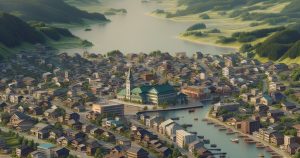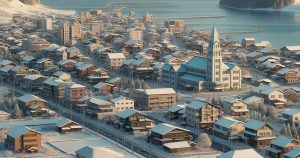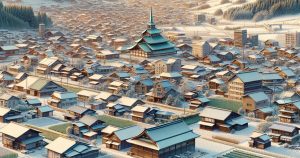| population | 56,925 peoples |
|---|---|
| area | 722.33 km² |
| population density | 78.8 peoples/km² |
Ishikari City, located north of Sapporo in central-western Hokkaido, is a beautiful coastal area where nature, history, and culture harmoniously coexist. Situated at the mouth of the Ishikari River, the city faces the Sea of Japan and has long thrived as a fishing and trading hub. The name “Ishikari” is derived from the Ainu language phrase i-sikar-pet, meaning “meandering river.” During the Meiji period, the region flourished through salmon fishing and timber transport, and today it continues to prosper as both a farming area and a suburban community of Sapporo.
The city is known for its fresh seafood, fertile farmland, and warm-hearted residents who cherish their connection with nature. Ishikari’s unique dialect and its deep Ainu cultural roots give the city a distinctive character. Annual events such as the Ishikari River Fireworks Festival and the Ishikari Salmon Festival showcase the community’s unity and cultural depth, offering visitors a vibrant glimpse of local life.
Culture and Traditions
Ishikari City has been home to Ainu settlements for centuries, and archaeological remains along the Ishikari River still tell stories of this ancient culture. After the Meiji era began, settlers from Honshu transformed the area into a key agricultural and fishing center. Today, Ishikari produces a variety of crops such as wheat, potatoes, melons, and the giant “Sapporo Large Cabbage.” Along the coast in Atsuta and Hamamasu districts, salmon and herring fishing continue to support the local economy.
The Ishikari dialect, a local variety of the Hokkaido dialect, adds flavor to the speech of its residents. Efforts to preserve Ainu culture are ongoing, with local museums and schools conducting cultural and language education programs. Major festivals such as the Ishikari Salmon Festival and the Rising Sun Rock Festival attract both locals and tourists, celebrating music, food, and tradition. Ishikari truly embodies the essence of Hokkaido—where nature and culture live side by side.
Local Specialties
- Ishikari Nabe (Salmon Hotpot): A local dish made with salmon and vegetables simmered in miso broth. The dish originated at Kindaitei, a long-established restaurant near the Ishikari River mouth.
- Atsuta Melon (Atsuta Red): A premium, sweet, and aromatic melon grown in the Atsuta district and shipped under the JA Kita-Ishikari brand.
- Hamamasu Beef: A brand of high-quality Wagyu raised in the Hamamasu district. Its well-balanced marbling and tenderness make it a local gourmet favorite.
- Mōrai Pork: Produced by North Best Farm in the Reitodori area of Atsuta, this pork is prized for its delicate sweetness and soft texture.
- Sapporo Large Cabbage: A giant cabbage variety that can weigh more than 10 kilograms. Cultivated mainly in the Mōrai area, it is perfect for pickling or hotpot dishes.
- Salmon Pie: A local specialty from Bonne Heure in Hanakawa. The flaky pastry and buttery aroma make it a popular souvenir.
- Fujimiya’s Steamed Buns: Oversized sweet buns sold at Fujimiya in Hamamasu, a beloved traditional confectionery shop.
Annual Events
- Ishikari River Fireworks Festival (late July) – Held near the Ishikari River mouth, featuring around 3,000 fireworks lighting up the night sky over the coast.
- Ishikari Salmon Festival (late September) – Celebrates the annual salmon run with local food stalls, salmon hotpot, and folk performances.
- Ishikari Ayame (Iris) Festival (June–July) – Takes place at the Ishikarihama Nature Observation Park, where 100,000 iris flowers bloom across the wetlands.
- Ishikari Winter Festival (February) – Held around the Hanakawa Kita Community Center, offering snow sculptures and ice candle displays.
- Rising Sun Rock Festival (mid-August) – One of Japan’s largest outdoor rock festivals, held at Ishikari Bay New Port Tarukawa Wharf.
Access
- By Air: About 1 hour and 20 minutes by car (80 km) from New Chitose Airport via the Dōō Expressway or Route 337.
- By Train: There is no train line within the city. The nearest stations are JR Shinoro Station and JR Teine Station, both connected by bus.
- By Bus: The Hokkaido Chuo Bus Ishikari Line runs from Sapporo Station North Exit to Hanakawa, taking about one hour.
- By Car: About 40 minutes north of downtown Sapporo via National Route 231. Convenient for accessing the Atsuta and Hamamasu coastal areas.
Tourist Attractions
- Ishikari River Mouth – The largest river in Hokkaido meets the sea here. The nearby Ishikari River Mouth Bird Sanctuary offers great birdwatching opportunities.
- Hamamasu Local History Museum (Former Shiratori Herring House) – A preserved wooden herring fishery building from the Meiji era, designated as a city cultural property.
- Mt. Koganeyama – A 739-meter peak within the Shokanbetsu-Teuri-Yagishiri Quasi-National Park, offering panoramic coastal views.
- Ofuyu Cape & Shirogane Falls – A scenic coastal waterfall and cliffside drive spot in northern Ishikari.
- Banya no Yu – A seaside hot spring with a stunning view of the Sea of Japan, especially beautiful at sunset.
- Ishikari Sand Dune Nature Center – A museum showcasing the city’s natural environment and cultural heritage, including sturgeon specimens and dune ecology exhibits.








